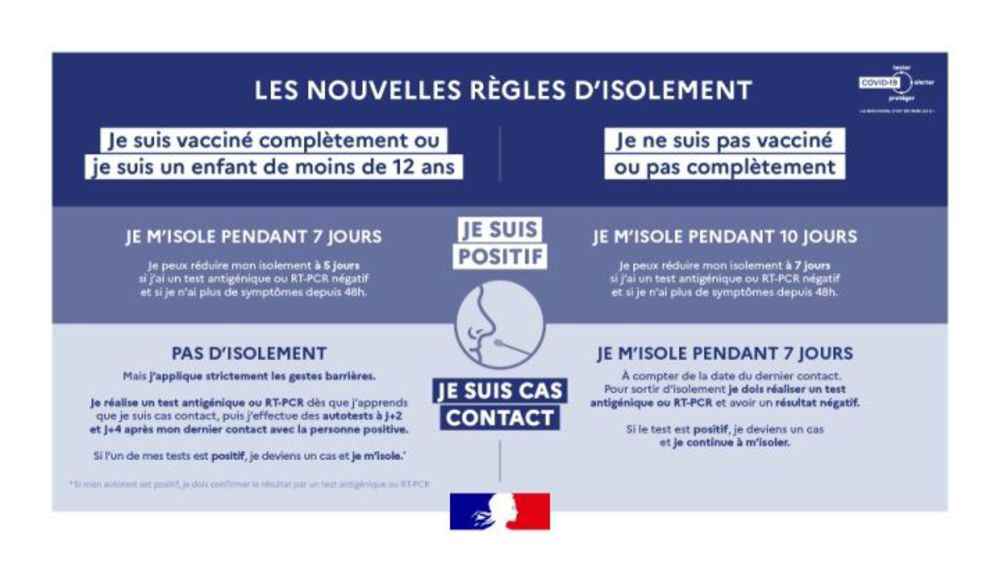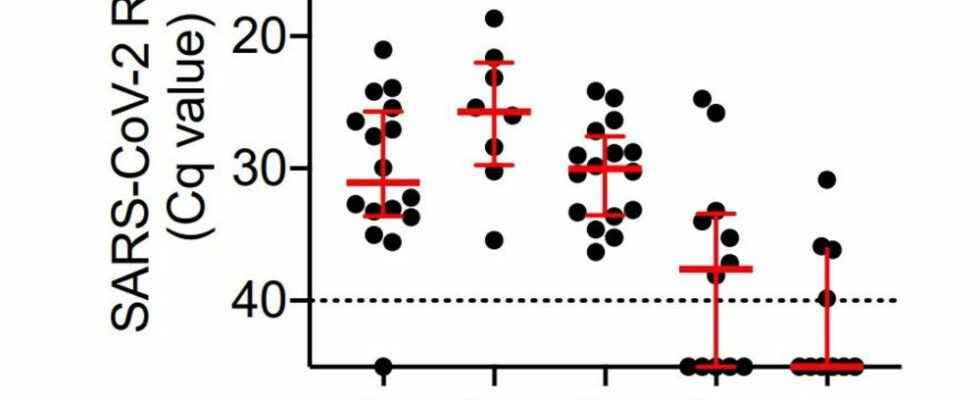End December, a study by the Centers for Disease Control and Prevention (CDC, USA) suggested that the incubation period of Omicron would be shorter than that of other variants. With the original strain of Sars-CoV-2, hosts generally developed symptoms six to seven days after infection on average, even up to fourteen days more exceptionally. The time to onset of symptoms had already gone down with Delta and was more like four or five days. With Omicron, the onset of symptoms would now be on average two to three days after infection, the CDC says. If the cause is not clearly established, two hypotheses can explain it: either it is an intrinsic property of Omicron – because it is able to attack our cells more quickly -, or the immune system of people who have already been vaccinated or infected reacts more quickly to the infection and would therefore cause symptoms sooner than before.
On January 5, a Japanese study this time looked at the viral load of people infected with Omicron. According to this work, the peak of the viral load – i.e. the period when the host is in principle the most contagious – occurs on average between three to six days after the onset of symptoms. With Delta, the peak was rather between two days before and two days after the onset of symptoms. If these preliminary works must be confirmed by other studies, they raise questions about the rule for isolating positive people, but also about the rules related to the appropriate time to carry out antigenic tests and self-tests for contact cases.
What does the Japanese study say?
The researchers studied 21 patients infected with Omicron: 19 were vaccinated, two were not, 17 were asymptomatic and four were symptomatic. The findings indicate that the viral load of symptomatic people, monitored with PCR tests, is particularly high one to nine days after the onset of symptoms. The peak is between three and six days. It is only from the tenth day that the viral load decreases significantly.
The viral load remains elevated for one to nine days after the onset of symptoms and peaks between three and six days.
Active epidemiological investigation on SARS-CoV-2 infection caused by Omicron variant in Japan
In order to refine their results, the researchers also cultured the various samples in the laboratory. Indeed, PCR tests may turn out to be positive when the samples contain only dead fragments of the virus. Their results confirmed the values of the PCR tests: the virus was not only present, but also alive up to nine days after the onset of symptoms. In other words, some patients were still infectious nine days after the onset of symptoms.
These results confirm in particular analyzes by epidemiologist and professor at Harvard University Michael Minawhich estimates that people infected with Omicron show symptoms more quickly than before, but also that Omicron peak infectiousness occurs after symptoms, contrary to what was observed with Delta, Alpha and the historical strain. The Japanese work also confirms a Taiwanese study conducted by the Central Epidemic Command Center, the Taiwanese equivalent of the US CDC. In this work, the researchers followed 23 people infected with Omicron. They assessed the patients’ viral load from the day they developed symptoms or from the day they first tested positive, which may explain some differences with the Japanese study results. Either way, the authors say all of the patients still had a high viral load — and were therefore likely still infectious — eight days after becoming infected or showing symptoms. 26% of them still had a high viral load between D+9 and D+12.
What are his limits ?
“The Japanese study is serious, notes Mahmoud Zureik, professor of epidemiology and public health at Versailles Saint-Quentin-en-Yvelines University and co-founder of the Collectif Du Côté de la Science. based on a small number of participants, the results must therefore be confirmed by larger studies. The Japanese study also has some inaccuracies, since the researchers do not indicate the nature of the symptoms that they took into account to fix the “zero time”, nor their duration. However, the symptoms of Omicron are different from those of the other variants. Loss of smell and taste is much less reported, while gastric problems, runny nose, cough, sore throat and headache, sweating, fatigue and muscle aches appear to be common. The study also does not indicate whether the viral load peaks on the third, fourth, fifth or sixth day.
“It should also be noted that Japanese researchers are studying the viral load, but we should not necessarily draw conclusions about contagiousness, adds Mahmoud Zureik. They indicate that the peak occurs between three to six days after the symptoms, which does not does not necessarily mean that the person is not contagious before these three days, especially since we know that Omicron clings quickly and easily to our cells. Moreover, they specify that the viral load drops after six days, but it remains significant on D+7, D+8 and D+9. It is only after ten days that the virus decreases significantly.
What does this change for current protocols?
Taking into account the work of the CDC and the Japanese and Taiwanese studies, it appears that the period when the viral load of people infected with Omicron reaches a peak – and therefore the period when they are most contagious – is between five and nine. days after infection. According to the CDC, the onset of symptoms is on average two to three days after this one; and according to the Japanese study, viral load peaks between three and six days after the onset of symptoms. Some people may also have a high viral load the day after the onset of symptoms, others may be contagious up to D+9. In conclusion, a person infected with Omicron could therefore be contagious between three and twelve days after infection.
Based on these results, are the new isolation rules in France adapted ? According to the authorities, people who are positive and not vaccinated must isolate themselves for ten days and only seven if they obtain a negative RT-PCR test. This period seems appropriate, even if it could be extended by two days. For vaccinated and positive people, the isolation time is set at seven days, or even only five with a negative RT-PCR test. If preliminary studies seem to indicate that vaccinated and nevertheless infected people are contagious for a shorter time, the isolation could nevertheless be extended by a few days. “Besides, 95% of the RT-PCRs carried out five days after contamination are still positive, remarks Pr. Zureik. The authorities clearly assume this duration of isolation of seven or ten days for health AND economic reasons. But if we take the risk of letting potentially contagious people go out, it is imperative to remind them of the importance of respecting and reinforcing barrier gestures in the days that follow.

Ministry of Solidarity and Health
The protocol for unvaccinated contact cases, who must isolate themselves for seven days and then obtain a negative RT-PCR test before going out, also seems suitable. But people who are in contact and vaccinated are not obliged to isolate themselves. They simply have to carry out an antigen or RT-PCR test as soon as they learn that they are a contact case (D+0), then a self-test on D+2 and D+4. However, according to American, Japanese and Taiwanese studies, contact cases should rather carry out a self-test between five and nine days after the last contact at risk. The result of these studies could also explain why so many people obtain a negative self-test result on D+4 and become positive a few days later, even if the potential failure of antigenic tests and especially self-tests to detect Omicron could be stake.
“The test on D+0 is almost useless, underlines Mahmoud Zureik. Those on D+2 and D+4 may possibly reveal a positivity, but the absence of positivity on D+4 does not indicate the absence of contamination. Especially since it appears that vaccinated people, even if they are less at risk of contaminating themselves than non-vaccinated people, seem to be more at risk of contaminating themselves. [avec Omicron] than with the other variants. Anyway, how many people have truly understood the current protocol? And among those who have understood it, how many apply it correctly?” And if it were necessary to simplify and recommend only one test after having contact? “Ideally, you should isolate yourself and perform a test on D + 7 “, says the specialist.
Victor Garcia
